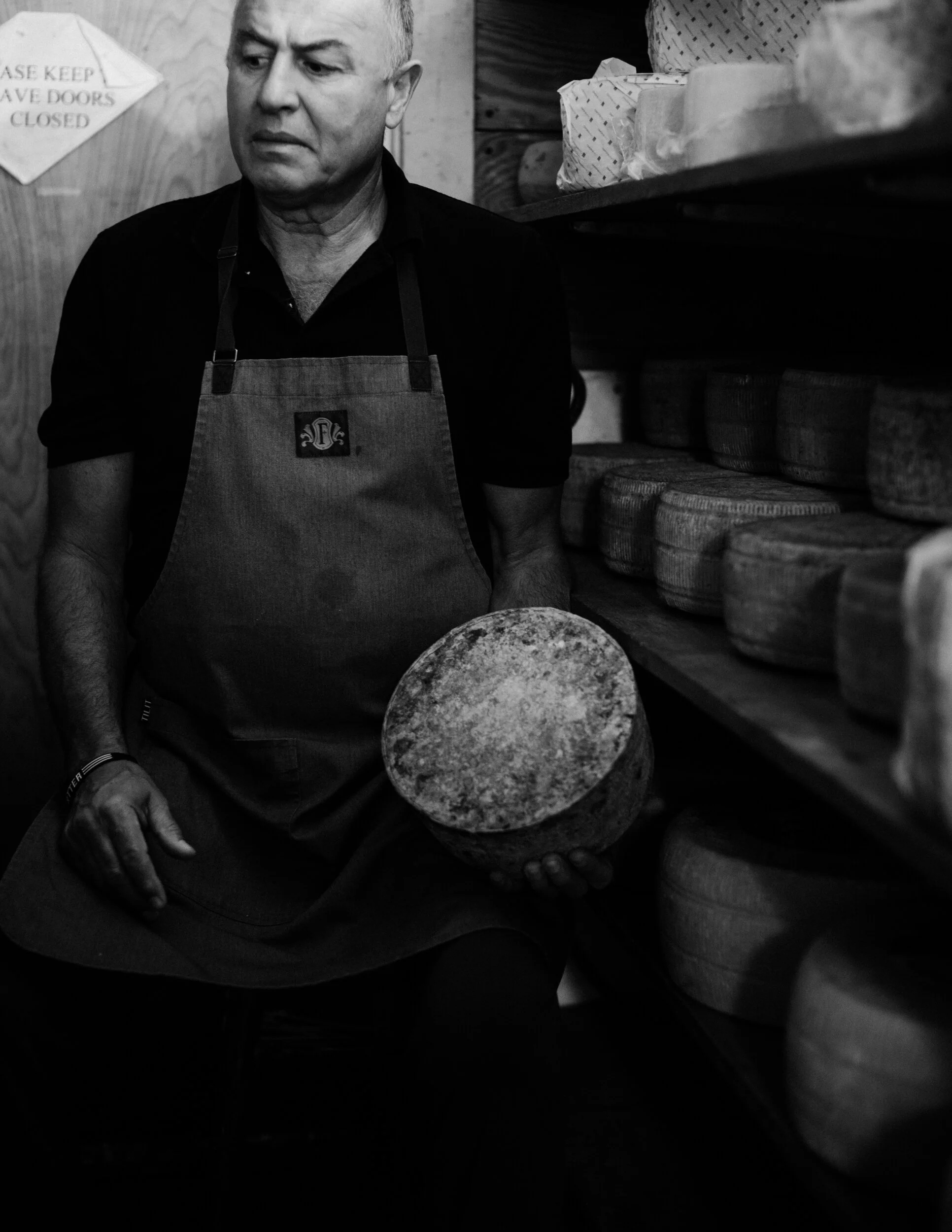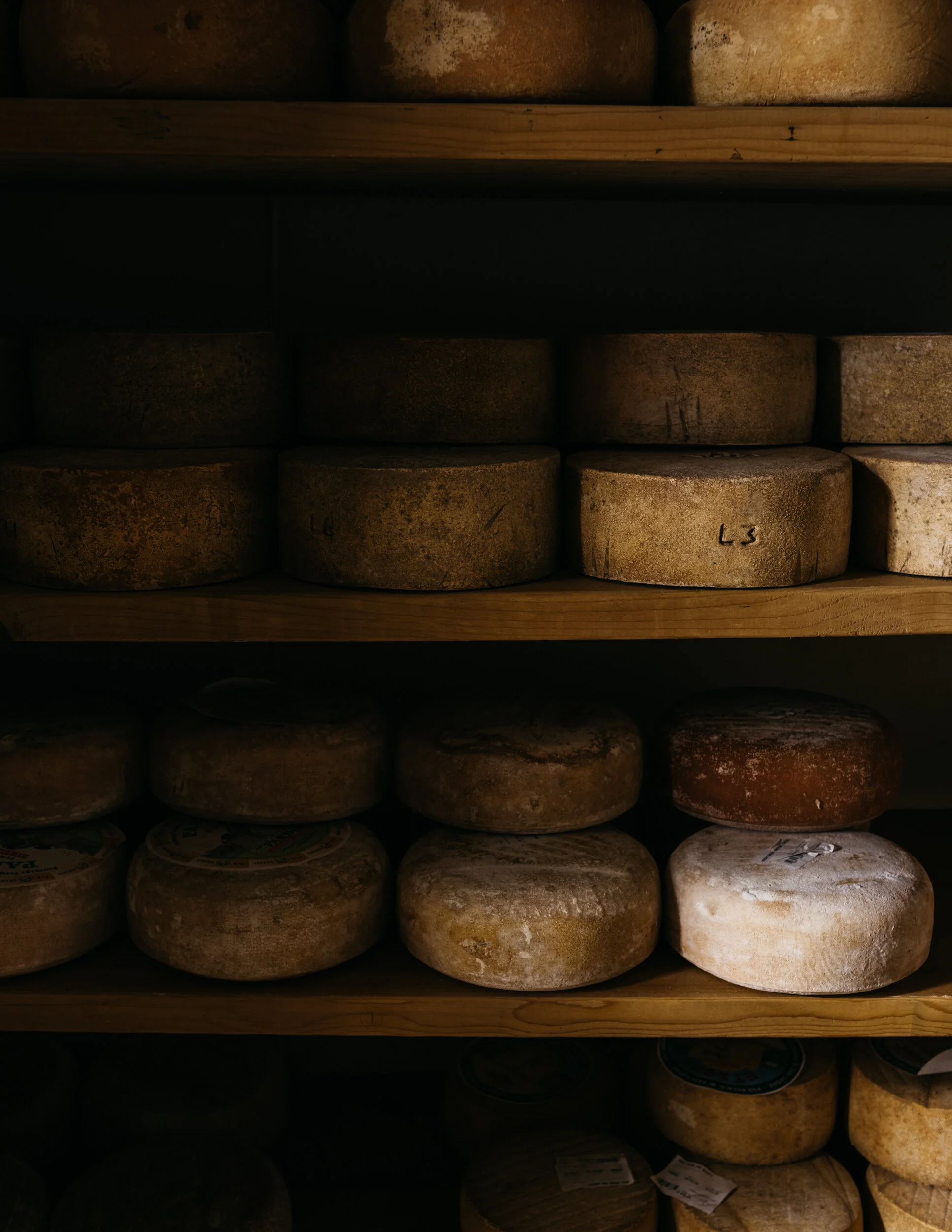At Formaggio Kitchen, an Education in Cheese
Photos by Michael Piazza
A few weeks before Thanksgiving, the dank basement walk-in refrigerator at Formaggio Kitchen in Huron Village, Cambridge—the first cheese cave ever built at a U.S. retail shop—was a little more sparse than usual. The specialty shop’s longtime owner, Ihsan Gurdal, had been expecting a pallet of sheep-milk cheeses to arrive from the Pyrenees. But, along with the rest of Formaggio’s latest order of perishables from the E.U., the delivery was held up at the French port where Gurdal consolidates his imports, for some uncontrollable reason.
It was a minor inconvenience, and just one of Gurdal’s concerns for the day. Besides the stress of the upcoming holidays, he was also in the midst of construction: He and his wife and business partner, Valerie, have taken over the nearby Fresh Pond Market with plans to reopen it early this year. The Gurdals’ newest store will be a neighborhood grocery and butcher shop like it previously was, with an expanded cheese selection.
Anyway, there was plenty more to sell while Gurdal awaited the arrival of the missing washed-rind wheels. But the delay is par for the course in a year that began with politically motivated tariffs on many of Formaggio’s most popular items, including Parmigiano Reggiano and French fruit jams. The continuing pandemic that followed is not only impacting Formaggio’s imports, but is also materially changing how plenty of customers shop. Beginning with months of unpredictable inventory caused by delayed deliveries and panicked shoppers, Formaggio is still limiting the number of customers allowed in-store—even though more phone and online orders mean less opportunity to wax hungrily about a particular wedge and make an unexpected sale.
Like so many other small business owners, Ihsan and Valerie Gurdal have had to roll with the punches—and rely on their community to help their business through the challenges. In the case of Formaggio Kitchen—which also has outposts in the South End of Boston and New York City, and a Kendall Square location that opened during the Huron shop’s 40th anniversary year—that community is large and devoted.
It includes many alumni and fans who have gone on to add their own flavor to the culinary world. The editor in chief of this magazine is a former Formaggio employee, as is the special projects editor. The list is loaded with Boston-area chefs and restaurant owners like Jason Bond of Bondir, Conor Dennehy of Talulla and Kate Smith, whose debut Thistle & Leek opened in September. Massachusetts wine importer Gemma Iannoni launched the Giannoni Imports portfolio with winemakers she met during her time at Formaggio. Twig Farm cheesemaker Michael Lee began raising goats after his Formaggio education from then head cheese buyer Matt Rubiner, who himself now owns a well-regarded cheese shop in Great Barrington.
With knowledge amassed in part by spending time flipping wheels in Formaggio Kitchen’s damp and chilly basement, this broad network is also a force to support cheesemakers at a crucial moment. Artisan cheese is endangered, says Rory Stamp, a one-time Formaggio cheesemonger who’s now the marketing manager at California’s Cowgirl Creamery and an industry consultant. The pandemic has disrupted the traditional cheesemonger-consumer dynamic, compounding the challenges for a métier already threatened environmentally and economically.
“When cheese just becomes another product on the grocery store shelf, it’s really hard to convince the consumer to buy that over something that’s produced on a commodity scale,” Stamp says. Like a sommelier does with wine, a cheesemonger helps translate, making esoteric labels as memorable as major brands. At Formaggio, Stamp could tell customers, “You’re going to taste a cheese Ihsan discovered by running into a rough-and-tumble cheesemaker, making this extraordinary deal to get this cheese in the U.S. for the first time.”
During the peak panic-buying period last spring, familiar Camemberts and Gruyères seemed all that anybody wanted, Gurdal says. To keep up interest in more unusual products, Formaggio staff started taking pictures of the coolers and shelves every morning, so customers could visually shop through social media. It’s been effective enough, Gurdal says, though he also acknowledges the benefit of his dedicated clientele. Stamp is advocating across the industry for a more collective approach, encouraging all of the small makers he works with to collaborate with local trade associations to engage customers—because not every cheese counter operates like Formaggio Kitchen.
“It’s an unbelievable market to sell cheese,” Stamp says. The worldly Huron Village regulars were always open to whatever wheel he was particularly excited about—but they had often tried it before, thus having expectations for how it was supposed to taste.
This is a welcome type of pressure for Stamp and likeminded mongers who have managed Formaggio’s impressive inventory. It is a job description-mandate to learn about—and therefore taste—as much cheese as possible.
“It was better than culinary school,” says chef Jason Bond, who sold cheese and brought in coffees, meats and other merchandise for the Gurdals, about a decade before he opened his Cambridge restaurant.
Michael Lee now produces two of Formaggio’s best-selling goat cheeses at his Vermont creamery, Twig Farm. From his days as a monger at the South End location, he philosophically recalls certain best-sellers, such as a sheep-milk wheel from the Pyrenees. (Incidentally, the same style that was recently out of stock because of the uncontrollable delays.) In the early 2000s, the store would receive every fresh batch the producer made. Lee and his colleagues tasted it daily.
“You would start to understand the seasonal variation,” he says. “The sum of all those different cheeses was circling around the idea of what the cheese is.”
Kate Smith began as a domestic cheese buyer at the South End location in 2018. She had just left her role as chef atToro with plans to eventually open a restaurant with her husband and fellow chef, Trevor. The Smiths realized that dream last fall with the opening of Thistle & Leek, a cozy gastropub in Newton Centre. On their nightly menu, the chefs offer a single cheese, sourced from Formaggio, paired with an accompaniment, such as a Welsh cow-milk selection and a sweet-and-spicy chutney in the style of a Branston pickle.
Smith is a purist, she says, appreciating the elegance of a ripe piece of cheese paired with something complementary. It’s a takeaway from Formaggio, which treats all of its products intentionally. The Huron Village store actually has two subterranean cheese caves, set at slightly different temperatures and humidity levels to optimize for different types of cheeses. The future cave at the Fresh Pond location, which Gurdal has the benefit of designing with two decades’ ripening experience, will have a unique water feature using a shower head to maximize moisture, inspired by a rig he saw at London cheese shop Neal’s Yard Dairy.
Yet Formaggio hasn’t always carried every hors d'oeuvre. After a “cocky” complaint that the well-stocked shop should, and could, make their own pâtés and terrines, Jason Bond began the in-house charcuterie program. “Ihsan was pretty much, like, ‘Well, go ahead,’” Bond recalls.
The added responsibility was empowering for the young chef. The Gurdals are “great bosses,” Bond says, and they inspire how he strives to treat his own employees. “They made me feel like I mattered,” he recalls, introducing him to VIP customers even as a new hire. “The community is tightly knit and very supportive.”
Formaggio continues to bolster Bondir: Both Cambridge locations sell Bond’s freshly baked croissants now on the weekends. It’s part of a concerted effort, Valerie Gurdal says, to feature local restaurants’ pandemic-driven packaged products.
Relationships are what has built the venerable market. Ihsan Gurdal met Valerie as a Formaggio Kitchen customer in 1984. The couple began traveling together, combining visits to Gurdal’s family in Istanbul with marathon tasting excursions throughout Europe. Around 1987, an old-timer East Boston importer helped Gurdal navigate the complicated system to bring in Formaggio’s first independent imports, some Italian products he tasted during his travels. The local importer “valued our account because we were more edgy,” Gurdal recalls—meaning Formaggio would stock products most American buyers had never even heard of.
The Gurdals’ voracious voyages led them into cheese caves beneath shops in Paris and London, where fellow cheesemongers explained to them the science of enjoying cheese at its peak. In 1996, Ihsan decided to build his own ripening room, which earned the attention of Julia Child. A Formaggio regular, Child checked out the cave on its first day of use. Gurdal brought down a chair for the octogenarian celebrity chef.
“She sat down and said, ‘These cheeses are as good as a very well-aged steak,’ and the next thing I knew we were published in 36 newspapers,” he recalls. “I even got a note from the Turkish government saying that they’re really proud of me. It’s incredible what she did for us.”
Also around that time, Gurdal received a phone call from Joe Moskowitz, the founder of an influential New York City food-supply logistics company. Moskowitz helped Formaggio set up more efficient systems for importing products. He also accompanied Gurdal on a formative trip to Geneva in 1999, shortly after the Swiss Cheese Union dissolved, which opened up the global market to dozens of new varieties. “It’s a very small circle at a certain level of quality of cheese,” Gurdal says. “Once the big players know what you’re working with, it opened such doors.”
Gurdal has kept them propped for his staff. Smith is one of many Formaggio employees who was sent to see the operations of regional cheesemakers, like the Vermont mecca Jasper Hill Farm. Stamp was among those who attended an exclusive wine exposition in Verona, Italy. In recent years, pre-pandemic, Gurdal has sought foreign trade grants to fund educational trips.
Michael Lee recalls a weeklong visit with the team at Neal’s Yard Dairy in the 2000s. Not only would he learn more about specific U.K. cheeses Formaggio sold, but he would also witness “how a really good cheese counter was run,” he says. “We’d take those ideas as inspiration on how we could fire up the crew at home.”
That was always the goal, Gurdal says: “To work with these special people that take so much pride in their product that it trickles down to my staff.”
As a marketing pro, Stamp helps craftspeople use social media to reach consumers they’re suddenly missing because of the lack of in-person interactions. The dedicated cheese lovers at Formaggio Kitchen will continue to share the stories, too—even if it’s in the form of an Instagram caption rather than a conversation interspersed with complimentary samples.
“If they’re into it, they’re going to sell it. It’s as simple as that,” Lee says. “That’s why we work with [Formaggio].”
Back in the Cambridge cheese cave, plump discs of Oma are situated on the wooden shelves, near where the anticipated Pyrenees wheels will eventually settle. A washed-rind specimen from Jasper Hill Farm made with cow milk rather than sheep, Oma isn’t a stand-in for the unavailable favorite—but it’s a worthy purchase on its own merits.
“I’ve really been thinking about the precarity of this industry,” Stamp says. “The call to action has to be: Support your local cheesemaker, wherever that might be.”
This story appeared in the Winter 2021 issue.


